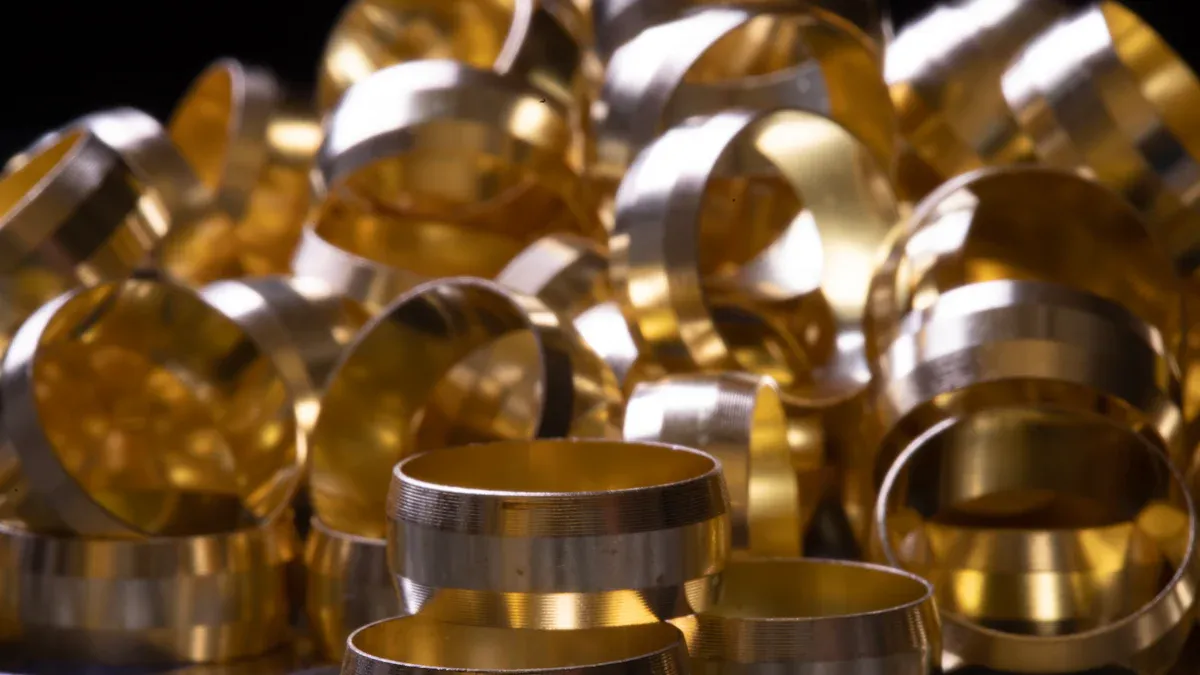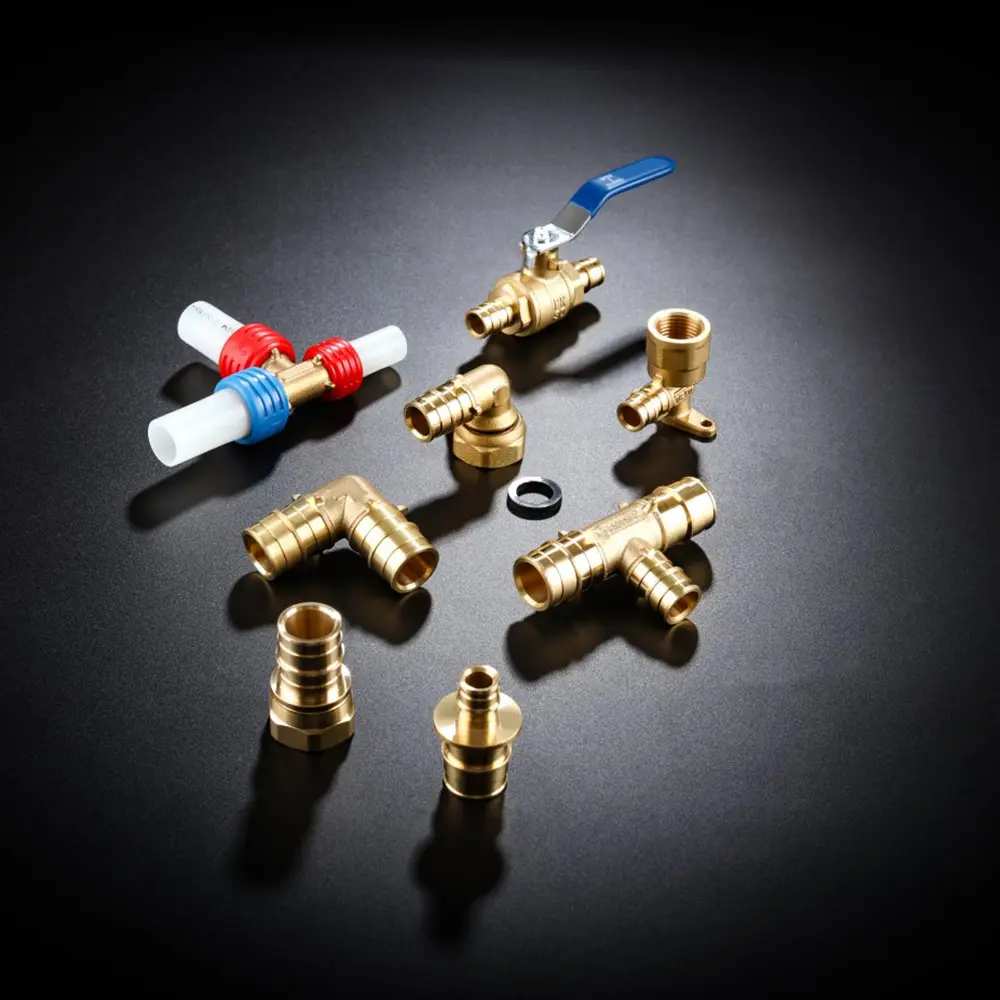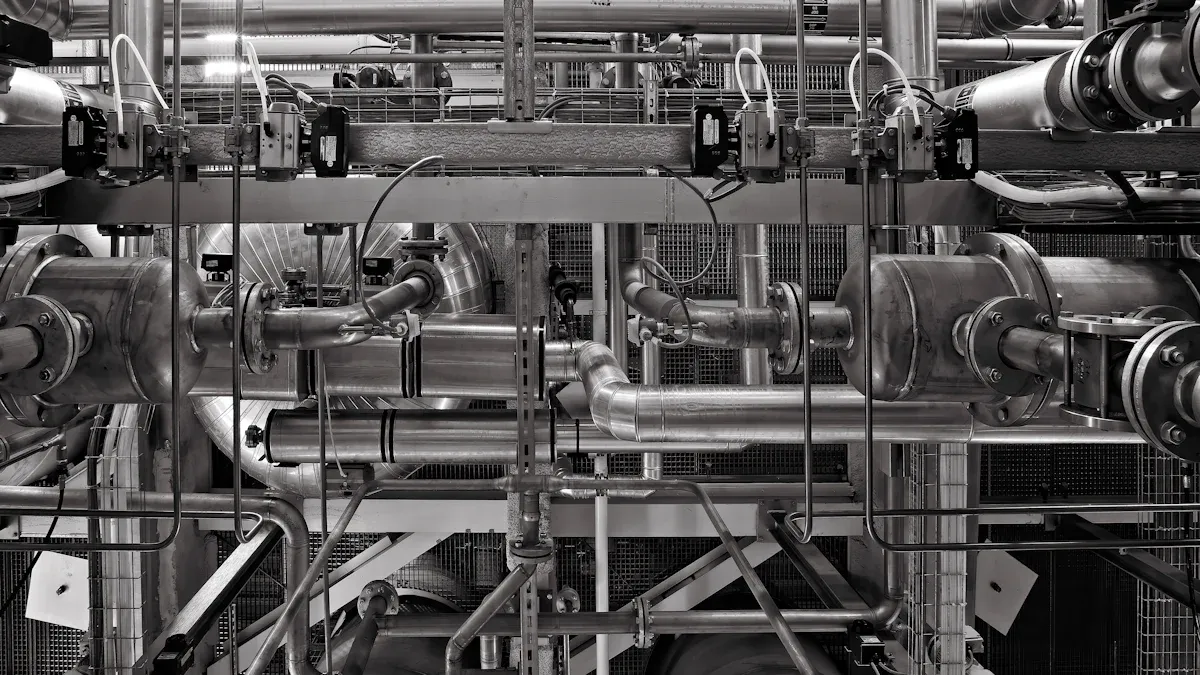
Quick and easy fittings simplify pipe connections with a push-fit mechanism, while compression fittings use a ferrule and nut system to secure pipes. Installation with quick and easy fittings requires minimal effort, making them ideal for rapid projects. Compression fittings, valued at $9.8 billion in 2023, dominate commercial applications due to their durability and adaptability.
Key Takeaways
- Quick and Easy Fittings are fast to install. They use a push-fit system, great for tight schedules.
- Compression Fittings create strong, leak-free connections. They work well under high pressure and are very safe.
- Think about pressure, heat, and reuse needs before picking fittings.
What are Quick and Easy Fittings?

Definition and Mechanism
Quick and Easy Fittings are innovative pipe connectors designed for fast and efficient installation. These fittings use a push-fit mechanism, allowing users to connect pipes without specialized tools or extensive training. By simply inserting the pipe into the fitting, the internal gripping mechanism secures it in place. This design eliminates the need for threading or welding, making the process straightforward and time-saving.
The engineering principles behind these fittings rely on compliant building elements (CBE). This approach ensures flexibility and reliability in the connection. The table below highlights key design principles:
| Design Principle | Description |
|---|---|
| Compliant Building Elements (CBE) | A systematic approach to design compliant mechanisms, including quick and easy fittings. |
| Automation of CBE | Automates the design process, making it accessible for less experienced users. |
| Matrix-based Design | Encodes quantitative data to enhance the flexibility and efficiency of connections. |
Key Features and Benefits
Quick and Easy Fittings offer several advantages. Their primary benefit is the ease of installation, which reduces labor costs and project timelines. These fittings are also reusable, making them ideal for temporary setups or frequent modifications. Additionally, they provide a secure and leak-proof connection, ensuring reliability in various applications.
Common Materials Used
Manufacturers typically use durable materials like brass, stainless steel, and high-quality plastics for these fittings. Brass offers excellent corrosion resistance, while stainless steel provides strength and durability. High-quality plastics are lightweight and cost-effective, suitable for less demanding environments.
What are Compression Fittings?

Definition and Mechanism
Compression fittings serve as reliable connectors for joining pipes or tubes in fluid and gas systems. Unlike welded or soldered joints, these fittings rely on a mechanical seal created by compressing a ferrule between a nut and the fitting body. This design ensures a leak-free connection without requiring specialized tools or heat-based methods.
The installation process involves four simple steps:
- Insert the pipe or tube into the fitting body.
- Place the ferrule around the pipe, positioning it between the nut and fitting body.
- Tighten the nut, which pushes the ferrule into the taper of the fitting body.
- Compress the ferrule to form a secure grip and seal.
This mechanism allows for easy disassembly and reconfiguration, making compression fittings ideal for applications like plumbing, gas pipelines, and hydraulic systems.
Key Features and Benefits
Compression fittings excel in both performance and convenience. Here are some standout benefits:
- Leak-Proof Connections: The ferrule design ensures a tight seal, preventing fluid or gas escape.
- High Pressure and Temperature Tolerance: These fittings perform reliably in extreme conditions, such as hydraulic systems.
- Ease of Installation: Assembly requires basic tools, reducing labor costs and installation errors.
- Durability: Their robust design minimizes the need for frequent repairs.
| Benefit/Metric | Description |
|---|---|
| Leak-Proof Connections | Ensures a tight seal, preventing fluid or gas escape, critical for safety and efficiency. |
| High Pressure and Temperature Tolerance | Designed to withstand extreme conditions, suitable for hydraulic systems and industrial processes. |
| Easy Installation and Maintenance | Can be assembled with basic tools, simplifying the process and reducing labor costs. |
Common Materials Used
Manufacturers use a variety of materials to meet diverse application needs:
- Stainless Steel: Offers excellent corrosion resistance and strength.
- Brass: Combines durability with cost-effectiveness.
- Plastic: Lightweight and suitable for low-pressure systems.
- Copper and Aluminum: Provide flexibility and thermal conductivity for specialized uses.
These materials ensure that compression fittings remain versatile across industries, including automotive, aerospace, and water treatment.
Comparing Quick and Easy Fittings and Compression Fittings
Installation Process
The installation process is a critical factor when choosing between Quick and Easy Fittings and compression fittings. Quick and Easy Fittings simplify the procedure with their push-fit mechanism. Users can connect pipes by inserting them into the fitting, which locks them securely without requiring tools or technical expertise. This approach saves time and reduces labor costs, making it ideal for projects with tight deadlines.
Compression fittings, on the other hand, involve a slightly more detailed process. They require the placement of a ferrule and nut around the pipe, followed by tightening to create a secure seal. While this method demands basic tools, it remains straightforward and accessible to individuals with minimal plumbing experience.
To illustrate the differences, the table below compares the installation processes of various fitting types:
| Fitting Type | Installation Process Description | Skill Level Required | Time Required |
|---|---|---|---|
| Quick and Easy Fittings | Push-fit mechanism; no tools or specialized skills needed. | Low | Minutes |
| Compression Fittings | Ferrule and nut tightening; requires basic tools but no advanced skills. | Low | Minutes |
| Soldered Fittings | Requires cleaning, flux application, and heating to melt solder; more time-consuming. | High | Longer |
Durability and Reliability
Durability and reliability are essential for ensuring long-term performance in piping systems. Quick and Easy Fittings excel in temporary setups or applications requiring frequent modifications. Their reusable design allows users to disconnect and reconnect pipes without compromising the fitting’s integrity. However, they may not perform as well under extreme pressure or temperature conditions compared to compression fittings.
Compression fittings offer superior durability due to their robust construction and high-quality materials like brass and stainless steel. These fittings withstand high pressure and temperature fluctuations, making them suitable for demanding environments such as hydraulic systems and industrial machinery. Their leak-proof design ensures reliability, reducing the risk of accidents or system failures.
Cost and Affordability
Cost considerations often influence the choice between Quick and Easy Fittings and compression fittings. Quick and Easy Fittings typically have a lower upfront cost, making them attractive for budget-conscious projects. Their simplified installation process further reduces labor expenses, contributing to overall affordability.
Compression fittings, while slightly more expensive initially, provide long-term value through their durability and reduced maintenance needs. Their ability to perform reliably in complex environments offsets the higher purchase price. Additionally, the wide availability of compression fittings in various specifications ensures cost-effective solutions for diverse applications.
Reusability and Maintenance
Reusability is a standout feature of Quick and Easy Fittings. Their push-fit mechanism allows users to disconnect and reuse them multiple times without compromising performance. This makes them ideal for temporary installations or systems requiring frequent adjustments. Maintenance is minimal, as these fittings are designed for quick disassembly and reassembly.
Compression fittings also offer ease of maintenance but are less reusable compared to Quick and Easy Fittings. Once installed, their ferrule-based design creates a permanent seal that may require replacement during disassembly. However, their durability reduces the frequency of repairs, ensuring long-term reliability with minimal upkeep.
The growing demand for efficient fluid transfer solutions highlights the advantages of both fitting types. Quick and Easy Fittings are projected to reach a market size of $800 million by 2025, driven by innovation and applications in industries like oil and gas. Compression fittings continue to dominate high-pressure systems, offering unmatched safety and performance.
Pros and Cons of Quick and Easy Fittings
Advantages
When I work with Quick and Easy Fittings, I immediately notice their simplicity. These fittings save time during installation. Their push-fit mechanism eliminates the need for specialized tools or advanced skills. This feature reduces labor costs and speeds up project timelines.
Another advantage is their reusability. I can disconnect and reconnect these fittings multiple times without compromising their performance. This makes them ideal for temporary setups or systems requiring frequent adjustments.
Durability is another strong point. Manufacturers use high-quality materials like brass and stainless steel, ensuring resistance to corrosion and wear. This reliability makes them suitable for various applications, from residential plumbing to industrial systems.
Tip: If you need a quick solution for pipe connections without sacrificing reliability, Quick and Easy Fittings are a great choice.
Disadvantages
While Quick and Easy Fittings excel in convenience, they may not perform as well under extreme conditions. High-pressure or high-temperature environments often demand more robust solutions.
Another limitation is their suitability for permanent installations. Although reusable, these fittings might not provide the same level of security as compression fittings in long-term setups.
Finally, their upfront cost can be slightly higher than traditional fittings. However, the savings in labor and time often offset this expense.
Pros and Cons of Compression Fittings
Advantages
When I work with compression fittings, I immediately notice their versatility. These fittings adapt to various piping systems, including cold water, hot water, and heating systems. Their ability to withstand high pressure and temperature makes them indispensable for demanding environments like industrial machinery and hydraulic systems.
Another standout feature is their durability. Compression fittings use high-quality materials such as brass and stainless steel. Brass resists corrosion, while stainless steel offers exceptional strength. This combination ensures long-term reliability and reduces replacement costs.
Safety is another key advantage. The ferrule-based design creates a secure connection that minimizes the risk of leaks or breaks. This feature enhances the overall safety of the piping system, reducing the likelihood of accidents.
Tip: Compression fittings are ideal for applications requiring robust performance and high safety standards.
Disadvantages
Despite their strengths, compression fittings have limitations. Poor installation can lead to complications such as pressure ulcers or tissue damage. I’ve seen cases where inadequate compression fitting caused nerve damage, particularly to the common peroneal nerve.
The table below highlights common risks associated with compression fittings:
| Evidence Type | Description |
|---|---|
| Skin Irritation | Risks include skin irritation and pruritus due to compression therapy. |
| Severe Complications | Rare complications like nerve damage and skin necrosis have been reported. |
| Pressure Ulcers | Linked to inadequate compression fitting, leading to tissue necrosis. |
| Nerve Damage | Peripheral nerve damage observed due to poorly fitted compression devices. |
Additionally, compression fittings may require replacement during disassembly. Their ferrule-based design creates a permanent seal, which limits reusability. While durable, this feature can increase maintenance costs over time.
Note: Proper installation and regular inspection are essential to avoid these risks and ensure optimal performance.
Choosing the Right Fitting for Your Needs
Applications for Quick and Easy Fittings
When I work on projects requiring rapid installation, Quick and Easy Fittings often become my go-to choice. Their push-fit mechanism simplifies the process, making them ideal for residential plumbing, irrigation systems, and temporary setups. For example, I’ve used these fittings in home renovations where time constraints demanded efficient solutions.
These fittings also shine in industries like construction and manufacturing. Their reusability allows frequent adjustments without compromising performance. In temporary water supply systems at construction sites, Quick and Easy Fittings provide a reliable yet flexible solution.
Their versatility extends to low-pressure applications. High-quality materials like brass and stainless steel ensure durability, even in environments prone to wear and tear. Whether connecting pipes in a greenhouse irrigation system or setting up temporary cooling systems, these fittings deliver consistent results.
Applications for Compression Fittings
Compression fittings excel in demanding environments where durability and safety are paramount. I’ve relied on them for high-pressure systems like hydraulic machinery and industrial pipelines. Their ability to withstand extreme temperatures and pressures makes them indispensable in these applications.
In plumbing systems, compression fittings offer a secure connection for both hot and cold water lines. Their leak-proof design ensures safety, reducing the risk of water damage or system failure. I’ve also used them in heating systems, where their robust construction handles the thermal stress effectively.
Industries like aerospace and automotive benefit from the adaptability of compression fittings. Their compatibility with various materials, including copper and stainless steel, allows integration into specialized systems. For example, I’ve seen them used in fuel lines and cooling systems, where reliability is non-negotiable.
Factors to Consider When Deciding
Choosing between Quick and Easy Fittings and compression fittings depends on several factors. I always start by assessing the project requirements, including pressure, temperature, and the need for reusability. For temporary setups or low-pressure systems, Quick and Easy Fittings often provide the best solution. Their ease of installation and reusability save time and effort.
For permanent installations or high-pressure environments, compression fittings offer unmatched durability and safety. Their robust design ensures long-term reliability, even in complex systems. When deciding, I also consider cost. While Quick and Easy Fittings have a lower upfront cost, compression fittings provide better value in demanding applications due to their longevity.
To make informed decisions, I use statistical tools like Bayes Factor, AIC, and BIC. These tools help evaluate the trade-offs between simplicity, durability, and cost. The table below summarizes their applications:
| Statistical Tool | Description |
|---|---|
| Bayes Factor | Quantifies model comparison using prior knowledge, considered a gold standard for model selection. |
| AIC | Akaike Information Criterion, used for model selection based on the trade-off between goodness of fit and model complexity. |
| BIC | Bayesian Information Criterion, similar to AIC but includes a stronger penalty for complexity. |
By applying these tools, I can systematically compare options and select the fitting that aligns with the project’s needs.
Quick and easy fittings prioritize speed and simplicity, while compression fittings excel in durability and high-pressure applications. I recommend quick and easy fittings for temporary or low-pressure systems. For demanding environments, compression fittings provide unmatched reliability.
Pro Tip: Always evaluate your project’s pressure, temperature, and reusability needs before choosing a fitting.
FAQ
What is the main difference between quick and easy fittings and compression fittings?
Quick and easy fittings use a push-fit mechanism for fast installation. Compression fittings rely on a ferrule and nut system for a secure, leak-proof connection.
Can I reuse both types of fittings?
Yes, but quick and easy fittings are more reusable. Compression fittings often require replacing the ferrule after disassembly.
Which fitting type is better for high-pressure systems?
Compression fittings perform better in high-pressure environments. Their robust design and materials ensure durability and safety under extreme conditions.
Tip: Always match the fitting type to your system’s pressure and temperature requirements for optimal performance.
Post time: May-27-2025
